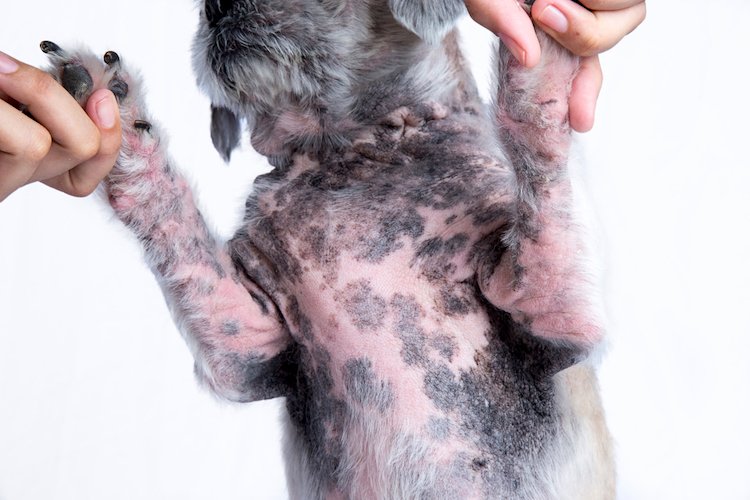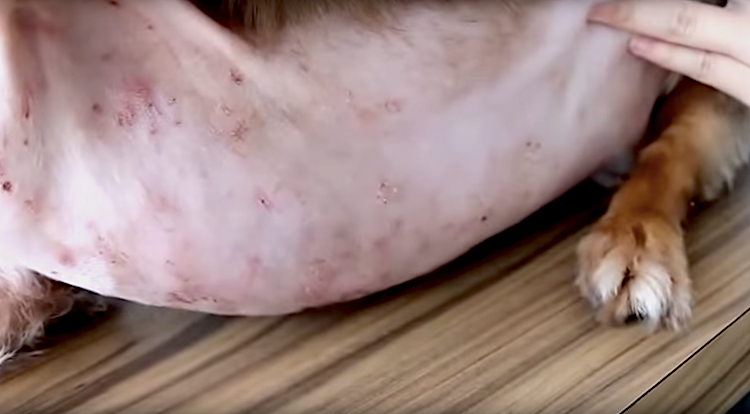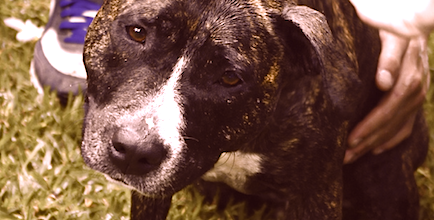Hyperpigmentation: When a Dog’s Tummy Has Turned Black
If your dog’s tummy turned black, trauma such as chronic licking, scratching or a skin infection could have happened months ago.

When a dog’s tummy has turned black, and it used to be cute pink or white, some pet lovers get concerned. People often think this is a sudden change in skin color, but most cases of hyperpigmentation happen over time.
Perhaps it’s the light in the room on a particular day that causes you to notice the change, or that one time your dog turns over and says, “Look, Ma, my pink belly has black spots now!”
Most causes of a change in skin color on a dog’s belly shouldn’t cause worry. But there are always exceptions, of course.
Table of Contents

Don’t leave your pet’s safety to chance
Sign up for Petful recall alerts today.

What Is Hyperpigmentation in Dogs?
Hyperpigmentation in dogs refers to areas of skin that become darker than the surrounding skin. This can be due to an excess production of melanin or other pigments, and it often occurs in response to inflammation, irritation, or hormonal changes. The two types of hyperpigmentation in dogs are:
Primary Hyperpigmentation:
This is less common and may be genetic or idiopathic (of unknown cause). It tends to be a cosmetic issue rather than a sign of underlying disease. Dachshunds, Whippets, and other breeds can be predisposed to primary hyperpigmentation.
Secondary Hyperpigmentation:
This is more common and occurs as a response to some kind of skin trauma, inflammation, or other skin disorders. Secondary hyperpigmentation can be due to a variety of factors:
- Inflammatory Conditions: Such as chronic dermatitis, where repeated scratching or irritation leads to darkening of the skin.
- Endocrine Diseases: Like hypothyroidism or Cushing’s disease, which can cause changes in skin texture and color.
- Friction: Areas that experience constant friction, such as armpits or under the belly, may darken over time.
- Allergies: Dogs with atopic dermatitis or food allergies may develop hyperpigmented areas as a result of chronic itching and skin trauma.
- Infections: Fungal infections (like Malassezia dermatitis) or bacterial infections can cause inflammation and hyperpigmentation.
- Parasites: Infestations with parasites, such as fleas or mites (like those causing scabies or demodicosis), can lead to skin irritation and subsequent hyperpigmentation.
- Lick Granuloma: A condition where a dog persistently licks a spot on its body, causing inflammation, infection, and hyperpigmentation.
- Sun Exposure: Just as with humans, prolonged sun exposure can lead to hyperpigmentation in dogs, especially in areas with sparse hair.
Most cases of skin darkening in a dog are secondary to other skin conditions or metabolic problems such as allergy, infection or endocrine disorders.
Skin discoloration doesn’t happen overnight — there has to be some degree of continual trauma or exposure for hyperpigmentation on a dog’s stomach or anywhere else to result.

Allergies and Hyperpigmentation in Dogs
Hyperpigmentation is most often associated with chronic itching. This is called pruritus-induced hyperpigmentation (translation: darkening of the dog’s skin caused by chronic itching).
You and your veterinarian have to manage the allergies causing the itching and chronically inflamed skin to treat the changes in skin color.
Although the skin may never return to its former light color, treating chronic skin conditions and the causes of itching and self-trauma is important for your dog’s health and comfort.
At this point, you might be saying to yourself that you haven’t seen your dog bothering their belly for a long time, so itching can’t be the cause of the hyperpigmentation. This is because the trauma, such as chronic licking or scratching or infected skin, could have occurred months before, and you are only noticing the color change now.
Think back to that redness that occurred last summer inside your dog’s legs or when the dog spent a couple of weeks licking their belly in October. Perhaps these same patterns of itching occurred over months or years. The color change from that chronic trauma may only be visible now.
Skin Infections and Hyperpigmentation in Dogs
Skin infections can occur on their own or can be secondary to allergies. No matter the cause, if the skin is infected, it can lead to hyperpigmentation.
Skin infections, like allergies, can be chronic. Your vet will get to the bottom of this and treat accordingly.
- Bacterial and yeast infections are the most common causes of skin infections in dogs.
- Mange (demodex and sarcoptic mange) can cause the skin to darken. Demodex lesions are usually local. Sarcoptes usually becomes generalized. The discoloration can resolve once the mange is treated but will remain in severe cases.
- Ringworm (dermatophytosis) can cause temporary or permanent hyperpigmentation in dogs.

Veterinarians will ask themselves the same questions you might be asking yourself on the way to a diagnosis:
- Why is the dog’s belly red or black? (Many causes are possible.)
- Why is it itchy? How itchy is it? (Allergies?)
- Why is it smelly? How smelly is it? (Yeast?)
- Is the dog itchy only at certain times of the year? (Allergies?)
- Do we have a thorough history on this dog since they were young? (Previous allergies or traumas?)
Once these questions are answered through history taking and diagnostics like skin scrapings, cytology, food trials — and maybe even biopsy — we will know how to treat the thing that’s causing your dog’s tummy to turn black.
If you’ve adopted a dog who now has quiet skin but has obvious areas of hyperpigmentation, it’s likely the dog suffered from skin trauma such as allergies when they were young.
Endocrine Disorders and Hyperpigmentation
Hypothyroidism, hyperadrenocorticism (Cushing’s disease) or sex hormone imbalances can cause hyperpigmentation. We generally have many other things going on with the dog than just a black tummy if the dog is hypothyroid or has another hormone imbalance.
Along with hyperpigmentation, these dogs can have large areas of fur missing, patchy fur loss, secondary skin infections, thinning hair, thin or thickened skin as well as changes in energy, thirst, appetite, etc.
Blood tests are required to diagnose endocrine disorders.

Dog’s Skin Turning Black and Losing Hair
When a dog’s tummy has turned black, thickening of the skin (lichenification) and/or hair loss (alopecia) can go along with hyperpigmentation, making the skin and fur look sad indeed.
Long, chronic skin allergies causing the dog to scratch and bite will cause the skin to become thickened (lichenified).
I see this most commonly in the groin area, the armpits and sometimes around the eyes and private parts, depending on where the dog is most itchy.
Genetic Disorders and Hyperpigmentation
- Dachshunds: Prone to a rare disease called acanthosis nigricans that causes hyperpigmentation followed by alopecia and lichenification.
- Huskies and related breeds: Prone to alopecia X, a syndrome that causes hair loss and hyperpigmentation.
- Yorkies, Silkies and crosses: Prone to melanoderma, a skin anomaly that usually causes hair loss and hyperpigmentation of the ears as well as color dilution alopecia, causing fur thinning and darkening of the skin on the body.
Miscellaneous Causes of Hyperpigmentation in Dogs
- Dog’s skin turning black after shaving? Post-clipper alopecia (translation: no fur regrowth after clipping or shaving) can result in hyperpigmentation. If fur does not grow back after grooming, extreme grooming or clipping due to surgery, the skin can become darkened in that spot. The darkening may fade with time, and the fur may grow back eventually after months and months. This is particularly true in Nordic breeds. Shaving close to the skin of those wonderful fluffy beauties, like Samoyeds and Akitas, is not recommended.
- Saliva from chronic licking can cause pigment changes of the skin and fur, particularly in dogs with light-colored coats. Think of the white Poodle with brown-stained feet. The fur as well as the underlying skin is darker from chronic licking. Foot-licking, usually due to allergy, can often be controlled or lessened but not always cured.
- Hyperpigmentation can be normal as a dog ages. Mild darkening of the skin from exposure to the sun and elements can occur, particularly in dogs with light or white coats.
- Any changes in hair cycle arrest, particularly in plush-coated breeds, can cause hyperpigmentation.
- Changes in hormones, including giving drugs like steroids or diethylstilbestrol (DES) for urinary incontinence, can cause hyperpigmentation.
- Dachshunds are hyperpigmentation mavens. This breed has a lot of pigment in their skin, and just about anything can cause discoloration. A black spot on the skin can result from even a small pimple!
- Deep scarring often leaves an area with no fur regrowth and hyperpigmentation.
- Many different skin disorders, including cancers and growths, can cause hyperpigmentation. These dogs clearly have fairly severe lesions and are not simple cases of darkened skin.
This dog suffers from atopic dermatitis, which means she’s very itchy and might scratch her skin enough to cause hyperpigmentation:
To pick up where we started and end here, the most common cause of hyperpigmentation in dogs is chronic licking or scratching (pruritic-induced hyperpigmentation).
Although you think you might be noticing your dog’s “black tummy” for the first time — maybe you’re thinking “Suddenly my dog’s skin is turning black and smells” or “Why is my dog’s skin turning black under their leg creases now?” — this is usually not the case. The changes are gradual and not a cause for emergency alarm.
If your dog is not exhibiting any scratching, licking or biting at themselves; has no obvious lesions on the skin other than the change in color; and seems normal in every other way, bring up the hyperpigmentation at your next vet visit.
References
- Hnilica, Keith A., DVM, et al. Small Animal Dermatology, 4th ed. Elsevier. 2016.
- Johnson, Kris. “Skin Hyperpigmentation, Dog.” VIN. April 2017.
- Miller, William H., VMD, et al. Muller & Kirk’s Small Animal Dermatology, 7th ed. Elsevier. 2012.
- Paoletti, Michael. “Post-Inflammatory Hyperpigmentation, Dog.” VIN. December 2017.








